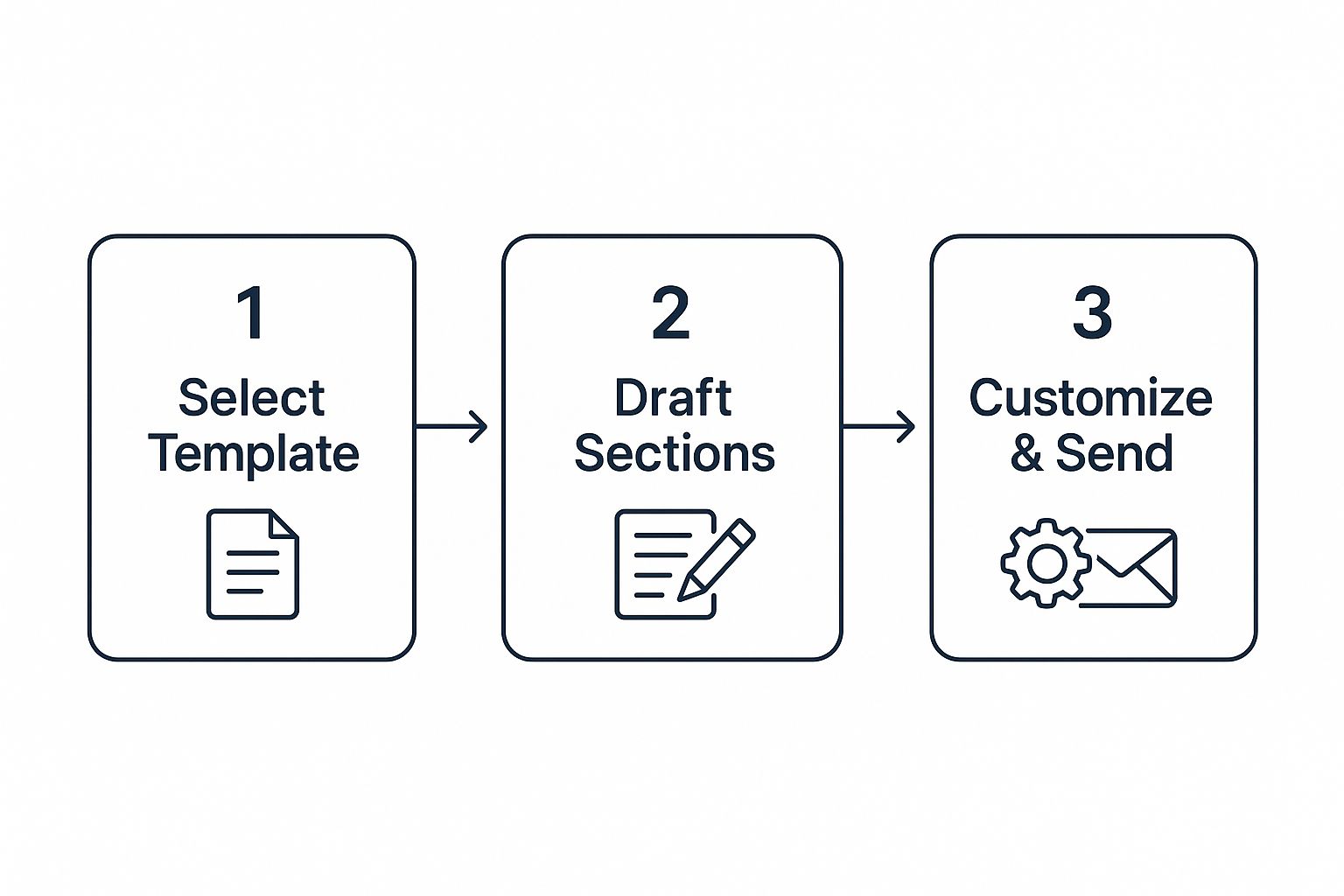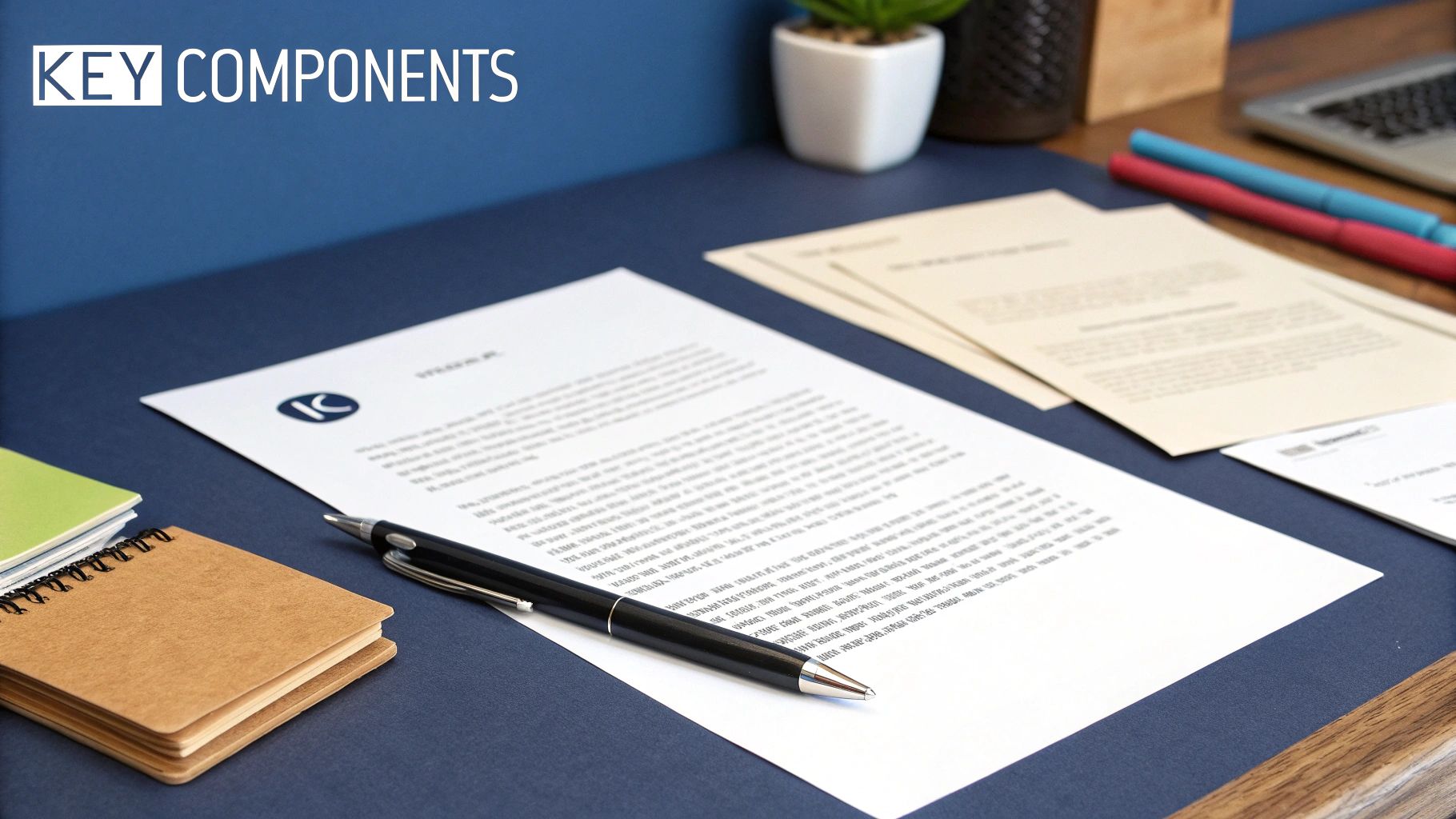Here’s your guide to the perfect query letter template: a one-page, four-part document designed to hook a literary agent. It’s a delicate balance—a personalized opening, a gripping story pitch, a professional author bio, and a polite closing, all wrapped up in a standard industry format.
A Proven Framework for Your Query Letter
Forget the terror of a blank page. Every great query letter follows a trusted structure that helps agents quickly find the information they need. Think of it as a blueprint for your book's first and most critical sales pitch. The goal is to be professional, compelling, and incredibly concise.
While the process feels overwhelming, you can really break it down into a few manageable phases, from finding the right structure to hitting "send" on a polished letter.

This just goes to show that a template is only your starting point. The real magic happens when you customize it and draft a submission that truly shines.
A Fill-in-the-Blank Template to Get You Started
Ready to build your own? Here is a strategic, fill-in-the-blank query letter template. Use this as your foundation, and we'll dive into what makes each component work in the sections that follow.
[Agent's Full Name],
[Personalized Opening Sentence that shows you've done your homework.] I am writing to seek representation for my [Word Count]-word [Genre] manuscript, [TITLE]. It will appeal to fans of [Comp Title 1]’s [unique element] and [Comp Title 2]’s [thematic element].
[Paragraph 2: Introduce your protagonist, their world, and the inciting incident that kicks off the story. What choice must they make?]
[Paragraph 3: Escalate the conflict. What are the stakes? What obstacles stand in their way, and what happens if they fail? Hint at the core emotional journey but—crucially—don't give away the ending.]
[Paragraph 4: Your author bio. Briefly mention any relevant writing credentials, professional experience related to your book's topic, or major awards. If you're a debut author, that's perfectly fine; just keep it short and professional.]
Thank you for your time and consideration.
Sincerely,
[Your Name]
[Your Contact Information]
Mastering this format is a direct reflection of your effective written communication skills—a quality every agent looks for.
The Anatomy of a Killer Query
Every single part of this template has a specific job to do. With agents receiving dozens of submissions daily, a clear and conventional structure is your best friend. It helps them instantly see your book’s vitals—title, genre, word count, and comps—before diving into the pitch itself.
To help you visualize how it all fits together, here’s a quick-reference table.
Query Letter Anatomy At A Glance
| Component | Purpose | Target Length (Words) |
|---|---|---|
| Hook & Vitals | Grab the agent’s attention and present your book's essential stats. | 50-75 |
| Story Pitch | Sell the story’s core conflict, stakes, and emotional journey. | 150-250 |
| Author Bio | Establish your credibility and professionalism as an author. | 25-50 |
| Closing | End the letter politely and provide your contact information. | 15-25 |
This little roadmap is perfect for helping you allocate your precious word count and ensuring every single sentence pulls its weight. No fluff allowed.
Crafting an Unforgettable Opening Hook

You get about two sentences. That’s it. In the time it takes an agent to scan those first few lines, they've probably already decided whether your query is worth their time or if it's getting deleted. Your opening isn't just an introduction; it's a high-stakes audition for your entire manuscript.
The mission here is twofold: immediately orient the agent and spark their curiosity. This opening paragraph has to efficiently deliver your book’s vitals—title, genre, and word count—and suggest its place in the market with smart comparative titles. The real art is doing all that without it reading like a sterile, robotic checklist.
Personalize Before You Pitch
First things first: address the agent by name. A generic "Dear Agent" is the kiss of death, immediately signaling that you've sent this query to a hundred other people. Doing your homework isn't optional. Find their name and, for goodness' sake, spell it correctly.
But real personalization digs a little deeper. A single, thoughtful sentence showing you’ve done more than just find their email address can make all the difference. Mention a book they represent that you genuinely admire, a recent sale they made that caught your eye, or an interview where they described their dream project—and it sounds like yours. This small gesture shows respect for their time and their specific tastes.
A quick tip from the trenches: Keep this part genuine and brief. A short, specific line like, "I'm querying you because of your fantastic work with [Author Name], and I'm hoping my dark academia novel will resonate with you," is far more powerful than a fawning paragraph of flattery.
This simple act transforms your query from just another email into a targeted proposal, making the agent much more receptive to the hook you’re about to drop.
Hook, Line, and Vitals
The most effective query openings fuse the story hook directly with the manuscript's key information. Instead of just listing the facts, you weave them into a compelling little package. You want the administrative details to feel like a natural part of the intro.
I’ve seen a few proven methods for structuring this critical first paragraph.
- Lead with Personalization: Start with that one custom line, then slide right into your pitch.
- Lead with the Hook: Just jump in. Hit them with a gripping sentence about your character and their central conflict, then follow up with the vitals.
- Lead with Comps: Position your book in the market first, then introduce your unique concept.
Let’s see how this actually looks.
Fiction Example (Thriller):
For seventeen-year-old hacker Alex, uncovering corporate secrets was just a game—until the secret he finds is a kill order with his sister’s name on it. I’m seeking representation for STATIC GHOST, my 85,000-word YA thriller that blends the high-stakes tech of Little Brother with the familial desperation of A Good Girl's Guide to Murder.
See how the vitals (title, word count, genre, comps) seamlessly follow the premise? The hook grabs their attention, and the details that follow give them the immediate context they need.
Comp Titles Are Your Secret Weapon
Choosing the right comparative (comp) titles is one of the most strategic moves you can make in a query letter. They’re a powerful shorthand for telling an agent about your book's tone, style, and ideal reader. Good comps prove you're well-read in your genre and you know exactly where your book would sit on a bookstore shelf.
Stick to these golden rules for picking your comps:
- Keep it Recent: Aim for books published within the last two to three years. This signals you're tapped into the current market conversation.
- Be Realistic: Please don't compare your debut to Harry Potter or The Hunger Games. Aim for successful, well-regarded books, but not once-in-a-generation phenomena.
- Get Specific: Don't just drop a title; explain the connection. A great formula is "[Comp Title 1]'s [specific element] meets [Comp Title 2]'s [another specific element]."
Nonfiction Example (Narrative Nonfiction):
I am writing to seek representation for THE FORGOTTEN FLEET, a 95,000-word narrative nonfiction account of the Alaskan Gold Rush's lost ships. My book offers the meticulous historical detail of David Grann's The Wager while capturing the deeply personal survival stories found in Endurance.
An approach like this tells the agent instantly what kind of reading experience you’re offering. It demonstrates market awareness and gives them a clear, professional framework for understanding your project’s potential right from the start.
Writing a Pitch That Sells Your Story
Think of your query's opening hook as the firm handshake. The pitch that follows? That's the heart of the conversation. This is where you go beyond the vitals and show an agent the soul of your manuscript.
This narrative summary, usually around 150-250 words, is your moment to prove you can tell a great story. It isn't a dry, point-by-point summary. It’s a condensed, high-impact narrative that needs to be every bit as compelling as your book itself.
Your goal is simple: make an agent feel the story's tension. Make them connect with your protagonist and truly understand what’s at stake. You need to pull them into your character's world so deeply that they forget they're reading a business letter and start feeling that old magic of why they fell in love with books in the first place.
The First Paragraph: Your Hero and the World-Shattering Moment
Start your pitch by grounding the agent in your protagonist's everyday reality—right before it all goes sideways. Who are they? What does their normal world look like? Most importantly, what do they want or believe just before the inciting incident shatters their status quo?
Don't just list character traits. Show us their core personality through their situation. Maybe your hero is a disgraced chef, clinging to the last shred of their dignity while flipping burgers in a small-town diner. Or perhaps she's a brilliant astrophysicist who has always preferred the quiet company of stars to people. Set the scene, but do it fast.
Then, hit them with the inciting incident. This is the catalyst, the event that yanks your hero from their ordinary life and launches them headfirst into the story's main conflict. It’s the shocking discovery, the looming threat, the unexpected invitation, or the tragic loss that ignites your plot.
Fiction Example (Fantasy):
Kaelen is a cartographer who has spent his entire life meticulously mapping the known world, perfectly content within the safety of its borders. But when a magical blight from the cursed Unseen Lands begins to literally erase his maps as it consumes the kingdom, he uncovers a devastating truth: the royal enchantment protecting the realm is failing, and he's the only one who can see it happening.
The Second Paragraph: Turning Up the Heat
Now that you've introduced your hero and their initial problem, the next paragraph has to raise the stakes. This is where you reveal the core conflict and the primary obstacles standing in your protagonist's way. What impossible choices will they have to make? Who—or what—is actively working to see them fail?
This section has to build a real, palpable sense of tension. The agent needs to understand not just the external challenges but the character's internal struggle, too. More than anything, they need to know what happens if the protagonist doesn't succeed. The consequences should feel dire, giving the story its emotional weight.
A great way to build this is to show your hero taking action, only to discover the situation is far more dangerous than they ever imagined. It’s this constant escalation that keeps a reader—and an agent—hooked.
Fiction Example (Fantasy, continued):
To restore the fading magic, Kaelen must journey into the Unseen Lands to find the legendary Sunstone, a relic most scholars are convinced is just a myth. His only guide is a disgraced knight exiled for treason, and they're being hunted by the Queen’s Inquisitors, who have orders to stop him at any cost to hide the kingdom's terrifying weakness. If he fails, the world he so carefully mapped will be swallowed by darkness, and everyone he loves will be lost forever.
The Third Paragraph: The Cliffhanger (Without Spoilers)
Your final pitch paragraph should bring the conflict to a boiling point without giving away the ending. Your job is to leave the agent with a powerful, lingering question that they can only answer by reading your book. This is usually done by presenting the protagonist with an impossible choice or a final, desperate gambit.
This is your cliffhanger. It hints at the climax and the emotional core of the story, making the agent need to know how it all resolves. Remember, you're selling the journey, not revealing the destination. This is a critical distinction in the overall book writing process, because it forces you to focus on what matters most: conflict and character.
Fiction Example (Fantasy, continued):
With the blight closing in and the Inquisitors on their heels, Kaelen learns the Sunstone’s true power comes at a terrible price: it will save the kingdom but shatter the mind of its user. He must now decide whether to sacrifice his own identity to save his world or watch everything he knows vanish into nothing.
Key Takeaway: The structure is simple: Character + Inciting Incident, followed by Action + Escalating Stakes, and ending with an Impossible Choice + Cliffhanger. This three-act structure in miniature is a powerful tool for any query letter template.
The pitch for a nonfiction project works a little differently, but the goal is the same. Instead of a character's journey, you're selling a powerful idea and its importance. You have to convince an agent that your topic is not only fascinating but urgently needed by a specific audience. It's all about showing a gap in the market and proving you are the absolute best person to fill it.
The publishing world is incredibly competitive, so that precision is essential. Literary agents can receive anywhere from 50 to 100 queries a week, with only about 1-3% of those leading to a manuscript request. Your pitch has to cut through the noise.
While your query is for a book, many principles of persuasive writing are universal. For example, learning how to write a compelling career change cover letter can offer transferable insights into structuring a powerful argument. This just goes to show why your pitch must be not just descriptive, but deeply persuasive. The whole structure of a query—a brief housekeeping section, a 150-300 word story description, comps, and a bio—is designed for this kind of high-speed evaluation.
Perfecting Your Author Bio and Closing

The author bio might be the last thing an agent reads in your query, but don't underestimate its power. It’s your final pitch—not for your book, but for you. This is where you prove you’re a professional and the only person who could have written this story.
Think of your bio as the answer to the agent's unspoken question: "Why you?" Keep it tight, usually just 25 to 50 words, and make every word count. It’s not a resumé; it’s a strategic snapshot of your credibility.
Crafting a Relevant and Punchy Bio
Relevance is everything. You need to draw a clear line connecting your life, your credentials, or your experience directly to the manuscript. If you're a debut author, don't sweat it. Countless writers land agents with a killer story and a professional, well-crafted bio.
So, what actually belongs in there?
- Writing Credentials: Have you won major writing awards, been published in respected journals, or earned an MFA? Put that front and center.
- Relevant Professional Experience: If you’re a marine biologist writing a thriller set on a research vessel, that’s gold. A historian pitching a WWII novel needs to mention their background.
- Direct Life Experience: This is obviously crucial for a memoir, but it can also lend deep authenticity to fiction.
- Author Platform: If you have a significant and relevant following—like a popular blog or a large social media presence related to your book's topic—mention it briefly.
Just as important is knowing what to cut. Leave out unrelated day jobs, generic hobbies ("I love reading and long walks on the beach"), and a long laundry list of minor writing credits. Stay sharp and focused.
A huge pitfall I see is writers apologizing for being new. Never, ever write, "Although I haven't been published before…" Present what you bring to the table with confidence. A simple, direct bio is always more effective than a rambling, defensive one.
Bio Examples for Every Author
Let's see how this works in practice.
For the Debut Author (with relevant experience):
I am a forensic psychologist with over a decade of experience profiling criminals. When I’m not working with law enforcement, I’m writing stories about the darkness that hides in plain sight. This is my debut novel.
For the Author with Writing Credits:
My short fiction has appeared in The Kenyon Review and Ploughshares, and my story "The Last Bridge" was nominated for a Pushcart Prize. I hold an MFA from the Iowa Writers' Workshop.
For the Nonfiction Expert:
As a certified financial planner and columnist for Forbes, I have spent fifteen years helping millennials navigate complex investment strategies. My popular weekly newsletter, Market Moves, reaches over 50,000 subscribers.
Your Professional and Confident Closing
You’ve hooked the agent, pitched your masterpiece, and established your credibility. All that's left is to stick the landing with a graceful and professional closing.
Your final paragraph has one simple job: to wrap things up politely and provide the necessary details. Let the agent know your manuscript is complete and available upon request. It’s a standard line, but an expected one.
Then, just sign off respectfully.
- Do: Use a classic, professional closing like "Sincerely," or "Thank you for your time and consideration."
- Don't: Get too casual with "Cheers," or "Best,". It can come across as overly familiar.
- Do: Make sure to include your full name, email address, and phone number below your sign-off.
A confident, straightforward exit shows you understand publishing etiquette and respect the agent's time. It leaves a final, lasting impression of professionalism.
How to Format Your Query for Readability
Sloppy formatting is one of the quickest ways to land your query in an agent's trash folder. Before they even read a single word of your pitch, they see the overall shape of your email. A messy, unprofessional presentation screams that you haven't bothered to learn the most basic industry standards—an immediate red flag.
Think of it this way: your query letter is the very first writing sample an agent ever sees from you. Clean, professional formatting shows you respect their time, understand the conventions of the business, and are serious about your career as an author. It's a simple but surprisingly powerful way to make a great first impression.
The All-Important Subject Line
Your subject line is your submission's first test. It has one job: to be clear, professional, and instantly informative. Agents get hundreds of emails a day. A vague or gimmicky subject line guarantees yours will be overlooked.
The goal is to give the agent the most critical information at a single glance. Stick to a standard, proven formula that works.
- For Fiction: "Query: [YOUR BOOK TITLE], [Genre], [Word Count]"
- Example: "Query: STATIC GHOST, YA Thriller, 85,000 words"
- For Nonfiction: "Query: [YOUR BOOK TITLE], [Author Name]"
- Example: "Query: THE FORGOTTEN FLEET, by [Your Name]"
- If you were referred: "Referred by [Referrer's Name]: Query for [YOUR BOOK TITLE]"
This clean, straightforward approach tells the agent exactly what they're opening. It's efficient and professional, two qualities every agent values.
Body Formatting the Right Way
Once they open your email, the visual presentation of your query continues to make its case. The industry standard is all about maximum readability on a screen. If you stray from it, you make your query harder to read, which gives a busy agent another easy reason to just move on.
The Professional Standard: Your query should be left-aligned with single-spaced lines. Use a blank line to separate your paragraphs instead of indenting the first line. This is called block formatting, and it’s the clean, modern standard for all business correspondence.
This isn't just a matter of opinion. The best practices are backed by what works. Good formatting prioritizes readability, which means using standard fonts like Times New Roman, Garamond, or Georgia at a comfortable 12-point size. Fancy fonts, colors, or creative layouts will only hurt you. The goal is to make your letter look clean and be effortless to read.
Final Touches for Professionalism
Before you finally hit send, run through a final check on a few small but absolutely critical details. These finishing touches demonstrate your attention to detail and give your submission that final layer of polish.
- Proofread. Then proofread again. Typos and grammar mistakes are the ultimate unforced error. Read your letter out loud, run it through a grammar checker, and then ask a trusted friend to read it over one last time. Seriously.
- Check the agent's guidelines. Always, always double-check the specific submission guidelines on the agent or agency's website. Some have unique formatting requests. Following their rules shows you've done your homework.
- Use a clean closing and signature. End with a simple, professional closing like "Sincerely," followed by your full name. Underneath your name, include your email address, phone number, and a link to your author website or relevant social media profile if you have one.
These formatting rules aren't arbitrary—they're the professional language of publishing. Mastering them is just as important as knowing the process for how to get an ISBN for my book. Each element shows you're a writer who is ready to be a professional partner.
Common Query Letter Mistakes to Avoid

You've spent months, maybe years, pouring your soul into your manuscript. After all that work, it's heartbreaking to see a query get rejected for a simple, avoidable error. These common mistakes are often the first red flags that tell an agent you're not quite ready for prime time.
Think of this as your final pre-submission check. Catching these issues now will make your query letter stand out for all the right reasons and signal that you're a professional who understands the industry.
Mistake 1: Querying an Unfinished Manuscript
This is the absolute cardinal sin for fiction writers. If an agent loves your query and requests the full manuscript, they expect to have it in their inbox that same day. Telling them you just need another "few months" to finish it up is a surefire way to get an instant rejection and burn that bridge for good.
For fiction, your novel must be 100% complete, edited, and polished before you even think about sending that first query.
The game is a bit different for nonfiction. Nonfiction books are frequently sold based on a comprehensive book proposal that includes sample chapters. You don't always need the full manuscript completed, but you absolutely need that killer proposal ready to go.
Mistake 2: Using Vague or Clichéd Descriptions
Agents have read thousands of queries. They can spot a cliché from a mile away. Phrases that might sound epic and profound to you often come across as generic fluff to a seasoned professional.
Don't do this: "This is a timeless story of love and loss that will make readers question everything they thought they knew about fate."
Do this instead: "When a cynical time traveler falls for a woman he knows is destined to die in a week, he must choose between preserving the timeline and rewriting history for a love that can't possibly last."
See the difference? The second example is packed with specifics. It gives us a character, a high-concept conflict, and impossible stakes. It hooks the reader with concrete details, not empty platitudes.
Mistake 3: The "And Then This Happened" Pitch
It’s so easy to fall into the trap of just summarizing your plot. "First, the hero finds the map. Then, he fights the dragon. Then, he rescues the princess…" This chronological play-by-play completely drains the tension and mystery from your story.
Your pitch is a sales tool, not a book report. Its job is to tease the core conflict and emotional stakes—to make the agent need to know what happens next. Focus on your protagonist, their goal, the impossible choice they face, and what's at risk if they fail.
Mistake 4: Projecting the Wrong Tone
The ideal tone for a query letter is quiet, professional confidence. You’re approaching the agent as a potential business partner, not as a desperate fan or an arrogant know-it-all.
- Avoid desperation: "I know you're very busy, but I would be eternally grateful if you would just take a tiny peek at my manuscript. It would mean the world to me." This just sounds amateur.
- Avoid arrogance: "I've written the next bestseller that will redefine the fantasy genre, and you'd be foolish to pass it up." This is an instant turn-off.
Let your story's killer hook and your polished, professional letter speak for themselves. A straightforward and respectful tone is always your best bet. By steering clear of these common blunders, you give your query the professional sheen it needs to make a fantastic first impression.
Frequently Asked Questions About Query Letters
Stepping into the world of querying can feel like learning a whole new language, and it's natural for questions to pop up along the way. Let's tackle some of the most common ones I hear from authors, moving past the template and into the nitty-gritty of sending your work out into the world.
How Many Agents Should I Query at Once?
I know it's tempting to blast your query out to every agent on your list, but trust me, a more measured approach works much better in the long run.
Think in small, strategic batches. I always recommend starting with a carefully researched group of 8-12 agents. This isn't just a random number; it's your test group. Their response (or lack thereof) is incredibly valuable data.
If you get a flurry of manuscript requests, that's a fantastic sign that your query and opening pages are hitting the mark. But if all you hear back are crickets or form rejections? That’s your cue to pause and reassess. It likely means something in your query package needs another look before you approach your top-choice agents. This strategy prevents you from burning through your dream list with materials that aren't quite ready.
Should I Follow Up if I Don't Hear Back?
Yes, but tread carefully. The golden rule is to always, always check the agent’s submission guidelines on their website first. Many agents will state their exact policy on nudges, and you have to respect it.
If they don't have a specific policy or say follow-ups are okay, it's acceptable to send one polite nudge after their stated response time has passed. This is usually around 8-12 weeks.
Keep your follow-up email short and professional. Just gently remind them of your submission (title, genre, date sent) and reiterate your interest in their consideration. Never send multiple follow-ups—it comes across as impatient and unprofessional.
What Is the Difference Between a Query and a Synopsis?
This is a big one, and getting it wrong can sink your chances. Think of it like this:
A query letter is your one-page sales pitch. It’s the movie trailer. Your only job is to hook the agent with your story's premise, conflict, and stakes so they feel compelled to read the book. You never spoil the ending.
A synopsis, on the other hand, is the full blueprint of your novel, typically one to two pages long. It lays out the entire plot from start to finish, including every major twist and, most importantly, the resolution. Agents need this to see if you can actually build a structurally sound story.
Can I Query an Unfinished Book?
For fiction writers, the answer is a hard no. Your manuscript must be completely finished, polished, and as perfect as you can make it before you even think about querying. When an agent requests your full manuscript, they expect to have it in their inbox that same day.
Nonfiction is the major exception here. You can often land a deal with a detailed book proposal, which includes sample chapters, a market analysis, and a full outline, rather than a completed manuscript. The path for how to become a published author can look different depending on your genre, but for novelists, a finished book is the first and most critical step.
Ready to turn your finished manuscript into a professionally published book? BarkerBooks offers everything from editing and design to global distribution and marketing. Let our team of experts help you achieve your publishing dream. Learn more about our author services at BarkerBooks.
